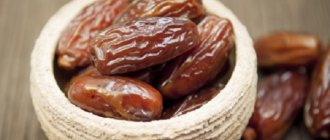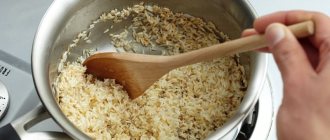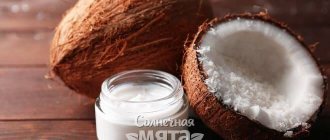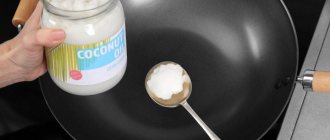Covered with a hard shell on the outside, inside which there is transparent tender milk and snow-white pulp, coconut remains a mysterious fruit for many residents of our country. Not everyone knows what beneficial properties this overseas “nut” has, and for what reasons the milk or pulp of this exotic delicacy should be included in your diet.
The fruit got its name from the Portuguese word coco, which translated into Russian means monkey. This is due to the presence of three spots on the coconut, which make it look like a monkey's face. The fruit grows in the Philippines, Thailand, Indonesia, Brazil, from where it is exported to our country.
What do coconuts look like and where do they grow?
Coconut trees are found in Sri Lanka, Indonesia and Brazil, and Thailand.
The fruit is a fruit with a hard shell containing pulp and liquid. As the nut ripens, the water becomes milk.
In fact, it is incorrect to call a coconut a nut. By botanical standards, it is a drupe, the same as an apricot or cherry. Coconut has all the characteristics of a drupe, has coarse fibers, a lot of liquid and a pit. An interesting fact is that coconut has a very rich vitamin and mineral composition, which can fully support the vital functions of the human body.
Nutritional value, composition and calorie content
Coconut meat is high in fat and calories, and moderate in carbohydrates and protein.
An 80-gram serving of fresh, grated coconut contains ():
- Calories : 283 kcal
- Protein : 3 grams
- Carbohydrates : 10 grams
- Fat : 27 grams
- Sugar : 5 grams
- Fiber : 7 grams
- Manganese : 60% of recommended daily intake (RDI)
- Selenium : 15% of RDI
- Copper : 44% of RDI
- Phosphorus : 13% of RDI
- Potassium : 6% of RDI
- Iron : 11% of RDI
- Zinc : 10% of RDI
Coconut meat is rich in several important minerals, especially manganese and copper. While manganese supports enzyme function and fat metabolism, copper promotes bone formation and heart health (,).
Fat
Coconut is a unique fruit due to its high fat content. About 89% of the fat in its pulp is saturated ().
Most of these fats are medium chain triglycerides (MCTs), which are completely absorbed in the small intestine and are used by your body for energy ().
Cellulose
Just 80 grams of shredded coconut meat supplies the body with 7 grams of fiber, which is more than 20% of the RDI ().
Most of this fiber is insoluble, meaning it is not digested in the gastrointestinal tract. Instead, it promotes food movement through the digestive system and gut health.
Summary:
Coconut meat is especially rich in calories, saturated fat and fiber. It also contains various minerals, including manganese, copper, selenium, phosphorus, potassium and iron.
Useful properties of coconut
The pulp contains a lot of indigestible dietary fiber, which is important for ensuring the normal functioning of the stomach.
They have a stimulating effect on peristalsis and, as it were, remove food debris from the walls of the esophagus and stomach. Coconut saturates the body with fats, but healthy ones that do not contain cholesterol.
The nut has a rich vitamin composition, these are B vitamins, there is vitamin A, PP, E and C. Coconut contains a large amount of copper. And it, in turn, plays an important role in the process of converting iron in the body, which stabilizes the amount of hemoglobin.
Thanks to lauric acid, coconut helps get rid of harmful microbes and improve the functioning of the stomach.
Coconuts for weight loss
Coconut is one of those products whose properties sometimes seem paradoxical. However, the high calorie content helps normalize weight when used correctly. However, such a complex product should not be experimented with by people who are obese to any degree.
However, if you are annoyed by a few extra pounds, then an exotic nut in combination with regular exercise will help you achieve good results in the process of body shaping. It is best to use coconut milk for weight loss because this product has minimal fat and carbohydrate content.
The principle of losing weight with coconut is based on the ability of two acids: lauric and dodecanoic. Both elements are capable of:
- actively burn fat reserves;
- speed up metabolism;
- normalize digestive processes;
- reduce hunger.
The high calorie content of exotic foods contributes to rapid saturation, but the presence of fiber prevents excessive weight gain. This means that vegetable fats entering the body are not stored as fat reserves, but are converted into energy.
There are many effective diets that will help you regain an attractive, slim figure. But it is better to choose such weight loss programs not for yourself, but on the recommendation of a nutritionist or endocrinologist. The fact is that excessive consumption of tropical fruits can disrupt the functioning of the heart and cause other serious pathologies.
Coconut juice. Benefits and harms
In our country it is quite difficult to find natural coconut water. It occurs exclusively in unripe fruits and is the basis for the formation of milk. It tastes like a sweetish-sour liquid. It is almost completely free of fat and has low calorie content.
The beneficial properties of water include:
- quick quenching of thirst;
- maintaining an optimal level of water balance;
- preventing the development of bacteria in the bladder.
In countries where coconuts are everywhere, fruit water is still used today as a saline solution. Water has a unique composition and can be used to moisturize the skin and be added to food.
There are no significant contraindications to drinking coconut water. But you should always remember that any product or liquid can cause an allergic reaction.
How to make coconut paste
1 option
Servings: 1.5–2 cups. Time: 15–20 minutes
Since coconut paste only contains one ingredient, coconut, you just need to figure out what to buy. Buy 100% unsweetened, desiccated coconut that is either shredded or sold as flakes. I suggest trying both as the texture is different for each. The flakes often turn into a smoother paste than grated coconut.
Coconut paste is delicious for any taste - from fried sourdough to pancakes. It's great in smoothies, coffee, or mixed with other nut butters and dark chocolate for a tasty treat. You can also add some to your favorite curries. And let's not forget the magic that works on the body. This could be a great hair mask or body scrub.
Using a food processor and high powder blender, place approximately 4.5 cups of coconut into the food processor or blender. Mixing time is about 15-20 minutes when using a food processor and 10-15 minutes (or less) when using a blender. For best results, stop the machine occasionally and scrape down the sides to push the coconut into the mixture.
Since you are making coconut paste, it will initially have a finely ground texture. Over time, it will begin to become somewhat thin and grainy, turning into a smooth, thick liquid. You may find that the final product seems runny, but when you taste it, it will have a thicker sticky texture, similar to grainy nut butter.
I like to keep mine in a glass jar at room temperature in my kitchen cupboard or cupboard. Once it cools to room temperature, this will help it achieve a firmer, spreadable consistency.
Option 2
An easy 10 minute 1 ingredient recipe to make coconut paste at home! No sweeteners or flavors - just pure, creamy coconut oil! Perfect for making desserts, sweet potatoes or just a snack!
Ingredients
- 3-4 cups dried (or shredded) unsweetened coconut*
- 1 pinch sea salt (optional)
- 1/2 teaspoon pure vanilla extract (optional)
- 1 cup stevia (optional)
Instructions
Add amount of shredded coconut (3 cups or 240g as written in original recipe // adjust as batch size changes) to food processor.
If your food processor is larger than 7 or 8 cups, you may need to add additional shredded coconut (1 cup or 80g as written in the original recipe // or more // adjust if you change batch size) to ensure there is enough content for grind and beat into “butter”.
Also, we tried using a blender and must say that it does not work because the blender lifts the coconut and does not allow it to be processed.
We've heard mixed reviews about how the Ninja blender/processor can whip coconut into "butter." So for this reason, we highly recommend using a Cuisinart food processor or similar model.
Mix until butter forms—sometimes up to 10 minutes—scraping down as needed. Mine usually takes about 8-10 minutes and I scrape the sides 2-3 times to make sure the coconut is well processed.
Once it's runny and creamy, you can add things like salt, vanilla extract, or stevia. But in my experience nothing is needed at all! If you still don't have coconut oil, chances are you either a) didn't add enough coconut flakes to your food processor, or b) your food processor probably isn't designed for this type of recipe or isn't powerful enough.
The main problem in making coconut paste is usually a problem of equipment rather than method. Store at room temperature for up to 2 weeks (sometimes longer). Depending on the temperature of your home, it will likely harden once it cools.
To use, you can either heat it in the microwave or place it in a shallow pan of very hot water and it will soften. Also, if you are putting on hot food, scoop and it should melt easily onto the food.
I love putting coconut butter on things like baked sweet potatoes, bananas, muffins, waffles, pancakes, smoothies, ice cream and oats, and especially just eating it straight out of the jar!
Coconut pulp. Benefits and harms
The pulp of the nut is very useful for maintaining the heart muscle. The natural fats included in the composition prevent the accumulation of harmful cholesterol, but, on the contrary, remove it from the body. The pulp is also useful:
- for joint diseases;
- while following a vegetarian diet;
- in the presence of nervous and urological diseases;
- to normalize hormonal levels;
- to improve the condition of diabetes of the second form;
- as an additional remedy for eye diseases and decreased visual acuity;
- as a stimulator of the metabolic process.
The pulp of the fruit helps prevent the development of atherosclerosis and prevent the development of cancer. Coconut will be useful for acne and as an anti-inflammatory agent.
Coconut helps reduce the negative effects of antibacterial drugs on the body. Drops are even made from the pulp to relieve ear pain.
Summarize
- Coconut meat is the white flesh of coconuts that is consumed fresh or dried.
- Rich in fiber and MCTs, it has a number of benefits including improving heart health, weight loss and aiding digestion. However, coconut meat is high in calories and saturated fat, so you should eat it in moderation.
- Overall, unsweetened coconut meat is an excellent addition to a balanced diet.
Tags: Coconut
- Related Posts
- Can you eat coffee beans? Benefits and harms
- Cowpeas (Vigna chinensis): benefits and harms, composition
- Pine nuts: benefits and harm to the body
« Previous entry
What does coconut treat and how to take it for medicinal purposes?
Coconut oil is widely used for medicinal purposes. It helps to get rid of discomfort after insect bites and heal wounds faster. It is added to tea when there is a sore throat. And if you rinse your mouth with water and oil, you can get rid of harmful bacteria and whiten your teeth.
Coconut oil helps relieve stress and quickly relax. To do this, rub a small amount of the product into your temples and scalp. Within just a few minutes, relief is felt. The oil is used to eliminate the manifestations of herpes; it also prevents wounds from spreading.
By consuming a small amount of oil daily, you can improve the functioning of the gastrointestinal tract, protect the heart muscle, and regulate cholesterol levels in the body. Regular consumption of oil promotes the healing of wounds on the gastric mucosa and reduces irritation.
The oil helps relieve nasal congestion and has a positive effect on the functioning of the thyroid gland.
The use of coconut in cosmetology
Despite its excellent composition, only oil from this nut is used in cosmetology. But this oil is suitable for hair, nails and skin. Oil is added to natural soap. Main properties of the oil:
- hydration;
- giving elasticity to the skin;
- restoration of healthy hair structure;
- getting rid of fragility and delamination;
- normalization of fat balance in both hair and skin;
- strengthening the nail plate.
The oil protects the skin from negative atmospheric influences. It is added to tanning products. It has pronounced whitening properties.
Coconut. Harm and contraindications
An allergy to coconut is extremely rare, but still, excessive consumption of pulp and milk can be harmful, primarily due to its high fat content.
A large amount of pulp can provoke an exacerbation of pathologies associated with the liver and stomach. And if there are problems with the digestive process, then the pulp will not be completely digested and will gradually accumulate in the stomach, which sooner or later will cause the appearance of individual intolerance. It is prohibited to consume coconut if you have phenylketonuria or gallbladder disease. Use is not recommended for liver disease.
How and with what do you eat coconut?
The easiest way is to break the coconut with a heavy object or a hammer. You can try to split it with a knife or pierce it with a knitting needle, but then you can only drink milk.
If the fruit pulp is young, then it can be eaten with a spoon. It can be cut into small portions and added to different dishes, stored in the refrigerator, by the way, its shelf life is at least 1 month. And if you make shavings, the pulp can be preserved even longer.
The pulp is mainly used to make desserts and add to cakes.
Coconut water
The vitamin and mineral composition of coconut water does not cover even 10% of the daily requirement. Its maximum usefulness is a sports drink.
Nutritional value of coconut water (per 100 g):
- Water - 95 g.
- Calorie content - 19 kcal.
- Carbohydrates - 3.71 g (sugar - 2.61, dietary fiber - 1.1).
- Fats - 0.20 g (saturated - 0.176, monounsaturated - 0.008, polyunsaturated - 0.002).
- Proteins - 0.72 g (tryptophan - 0.008, threonine - o.026, isoleucine - 0.028, leucine - 0.053, lysine - 0.032, methionine - 0.013, cystine - 0.014, phenylalanine - 0.037, tyrosine - 0.022, valine - 0.044, ar ginin - 0.118 , histidine - 0.017, alanine - 0.037, aspartic acid - 0.070, glutamic acid - 0.165, glycine - 0.034, proline - 0.030, serine - 0.037).
- Calcium - 24 mg.
- Iron - 0.29 mg.
- Magnesium - 25 mg.
- Manganese - 142 mg.
- Phosphorus - 20 mg.
- Potassium - 250 mg.
- Sodium - 105 mg.
- Zinc - 0.10 mg.
- Copper - 0.040 mg.
- Selenium - 1.0 mcg.
- Ascorbic acid (vitamin C) – 2.4 mg.
- Thiamine (vitamin B1) - 0.030 mg.
- Riboflavin (vitamin B2) - 0.057 mg.
- Niacin (vitamin B3, PP) - 0.080 mg.
- Vitamin B6 - 0.032 mg.
- Folic acid (vitamin B9) - 3 mcg.
- Pantothenic acid (vitamin B5) - 0.043 mg.










